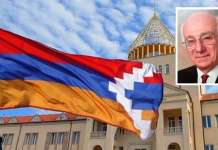The collapse of the Soviet Union left behind many unresolved territorial issues which have come to be categorized as “frozen conflicts.” Nagorno Karabagh was one such “frozen conflict,” which today has been defrosted, thawed and even become one of the very hot spots of the region.
Karabagh is now caught in a whirlwind generated by the recent power reconfigurations in the Caucasus region.
An axis is being formed, bringing together Russia, Iran, Turkey and Azerbaijan. Armenia is left out to nobody’s chagrin, but the Karabagh conflict remains one of the stumbling blocks towards the full coagulation of the new alliance.
Since the signing of the cease-fire regime in 1994 between Armenia and Azerbaijan, brokered by the Kremlin, the Karabagh issue has been a permanent feature on the agenda of the Organization for Security and Cooperation in Europe (OSCE). For a period of time, Karabagh was party to the negotiations, but upon Azerbaijan’s objections, it was removed from the negotiation table and Yerevan did not make an issue out of it in order not to jeopardize the ongoing talks. However, at this time, negotiations have intensified between Russia, Turkey, Iran and Azerbaijan, and even Armenia itself has been marginalized.
After his recent meeting with President Vladimir Putin in St. Petersburg, President Recep Tayyip Erdogan made a blunt statement to the Turkish Aksam newspaper, saying: “There is progress in the resolution of Karabagh conflict. … To begin with if the five regions occupied by Armenian forces are liberated, then we can talk about the process of regulating the region. … The entire world is aware that Azerbaijani territories have been occupied by Armenia. … If all the parties accept this fact, then why not put an end to the occupation?”
Adding insult to injury, Turkey’s Foreign Minister Mevlut Çavusoglu has said that the Karabagh conflict will be tackled between Azerbaijan, Turkey and Russia, which can satisfy all parties. The foreign minister deliberately left out Armenia and Karabagh to insinuate that whatever resolution arises from the collaboration of this grouping must be accepted by the latter.
Ordinarily, these pronouncements could be taken at face value, were it not for other factors that have come to give credence to these statements. The fact that in President Serzh Sargsyan’s speech there is assurance that there will not be “unilateral concessions” in the settlement of the Karabagh negotiations leaves open the possibility that something is in the works to force the surrender of some territories. Sargsyan’s statement is exacerbated by President Putin’s statement, after President Ilham Aliyev alluded to ceding five regions by Armenian forces, in response to a reporter’s question: “I do not interpret statements from my colleagues.”
Therefore, the question remains unanswered and open to interpretation and speculation.
One of the triggers of the recent unrest in Armenia was the rumor that the government had already agreed to return the territories. Those who are against that concession argue that Azerbaijan is bent on waging a war at any stage. Should that war come after ceding the territories and expanding the borders with Azerbaijan and rendering Karabagh more vulnerable, we would prefer war now while we have the upper hand.
Incidentally, the unrest is caused not only with the developments in the Karabagh conflict, but because of other factors as well, chief among them being the complete loss of the credibility of the government.
There are a number of legitimate factors that led to the revolt. No one questions the patriotism of the members of Sasna Tsrer, who took up arms and occupied the police station at Erebuni in July. But outside forces, which have brought about “color revolutions” in other regions, bank exactly on these legitimate causes to promote their selfish agendas. Whipping up anti-Russian sentiments and calling to join NATO (of all people by decent opposition figure filmmaker Dikran Xmalian) point to the signature of the merchants of the color revolutions behind some of the unrest.
Armenians are faced with the unpleasant choice of land or peace. But does that formula resolve the problem forever when Aliyev keeps spreading the falsehood that present-day Armenia itself is considered historic Azeri land and when in the 21st century Turkey’s Deputy Prime Minister Bilani Yildirim maintains that the deportation (or Genocide) of the Armenians was justified in 1915 and if necessary, should be repeated?
If the plan of land for peace is executed, which party can guarantee Armenia’s security?
Let’s look at some historic precedents. To end the atrocities in Sudan, the country of South Sudan was created, but the war continues, this time by the respective factions backing the president and the vice president. Similarly, Serbia was amputated to create Kosovo, which until today, is under NATO tutelage. The moment NATO leaves, the war will resume.
In all probability, Moscow will be delighted to introduce its peacekeeping forces in the region. But Armenians have the historic parallel of Cilicia, where they returned after fighting a victorious war. But the French colonizers, who had promised a homeland under their protection, disarmed the Armenians and betrayed them, joining the Kemalists instead.
Therefore, unless Armenia develops sustainable military power to defend itself, it cannot delegate the security and the lives of its citizens to any strategic ally.
Thus far, OSCE has been the main forum dealing with the Karabagh conflict. With two of its members, namely Russia and Turkey, drifting apart, the issue has been transferred to a different arena and that shift is reflected in the arrogant pronouncements of the leaders in Turkey and Azerbaijan. No concrete facts have come out of the recent negotiations. Positions and policies on the Karabagh conflict are being discussed based on scant leaks to the media.
Azerbaijan has never conceded that Karabagh may become independent after ceding all seven regions in question. It has not even accepted the notion of a referendum in the immediate future. All that Baku has promised is a “high level of autonomy within the borders of Azerbaijan,” and this is only a vague promise, which has met with intransigence on the Armenian side.
After much anticipation and speculation, finally a former Kremlin insider, Andranik Mihranian, let the cat out of the bag in an interview on August 14 with www.tert.am.
He said: “I believed that even a child in Armenia could understand that territories had to be exchanged for the approval of independent status for Nagorno Karabagh by the government of Azerbaijan, with the international community — OSCE Minsk Group and others — to be guarantors.”
Mr. Mihranian believes that even an interim status would be “a brilliant fantastic victory for Nagorno Karabagh” because “it would allow Nagorno Karabagh to stop being a part of Azerbaijan within international law.”
Azerbaijan maintains that Karabagh is the integral part of its territory. But Karabagh, as an autonomous oblast, was brought under Baku’s jurisdiction during the Soviet era. Karabagh respected the validity of Soviet constitution and to cede from the Union and from Azerbaijan, the nation held a referendum. Additionally the Republic of Azerbaijan considers Soviet rule as illegal occupation of its territory. Therefore, if Soviet jurisdiction was illegal, how can the Soviet annexation of Karabagh to Azerbaijan be valid? But Turkey and Azerbaijan are using the Islamic card to pass four resolutions at the UN against Armenia to be able to cite that the “international community” endorses Baku’s claim.
“No Armenian leader,” continues Mihranian, “especially Serzh Sargsyan, who has from the outset been involved in the struggle for Artsakh’s independence, will return an inch of land for just no reason, without guarantees for Nagorno Karabagh’s independence and security.”
Had Mihranian’s statements not been corroborated by other sources, it may have been considered a lone voice in the wilderness. Now, we see another voice seconding his claims. That source is another Kremlin player, political analyst Oleg Matveychenko, who has published an article titled “It Is Already Time to Heal the wounds.” It is believed that the article is a trial balloon being floated to test the reactions in Armenia, Karabagh and Azerbaijan about a new package of proposals by the OSCE leadership.
Under five headings, the writer details the scenario of the exchange of territories against Karabagh’s independence and the right to join Armenia.
As they say, the devil is in the details; the writer proposes a corridor in the Meghri region, which encroaches on Armenia’s sovereignty. The narrow corridor, only 150 meters wide, will allow Azerbaijan to communicate with Nakhichevan, incidentally another Armenian oblast given to Azerbaijan by the Soviet overlords. It is kind of a Paul Goble Proposal 2, to which former President Levon Ter-Petrosian had answered that when peace is established, Azerbaijani trucks, trains and planes will cross Armenia’s territory without a special agreement compromising its sovereignty.
There are also other details, which if enforced, may meet the rejection of both parties. The package in its major outlines may indicate a movement in the positive direction. But word about Karabagh independence must be uttered by the Azerbaijani side.
The question is whether recent uproar in Armenia strengthened or weakened the president’s hand at the negotiation table. This writer believed that it could weaken it, but it seems that the popular resolve has resonated beyond Armenia’s borders, warning all interested parties that Armenia is against the wall and cannot be pushed any further.
At this time, Karabagh is in the whirlwind of negotiations. Once the whirlwind subsides, we will find out if Karabagh will become independent, semi-independent or still besieged.
















